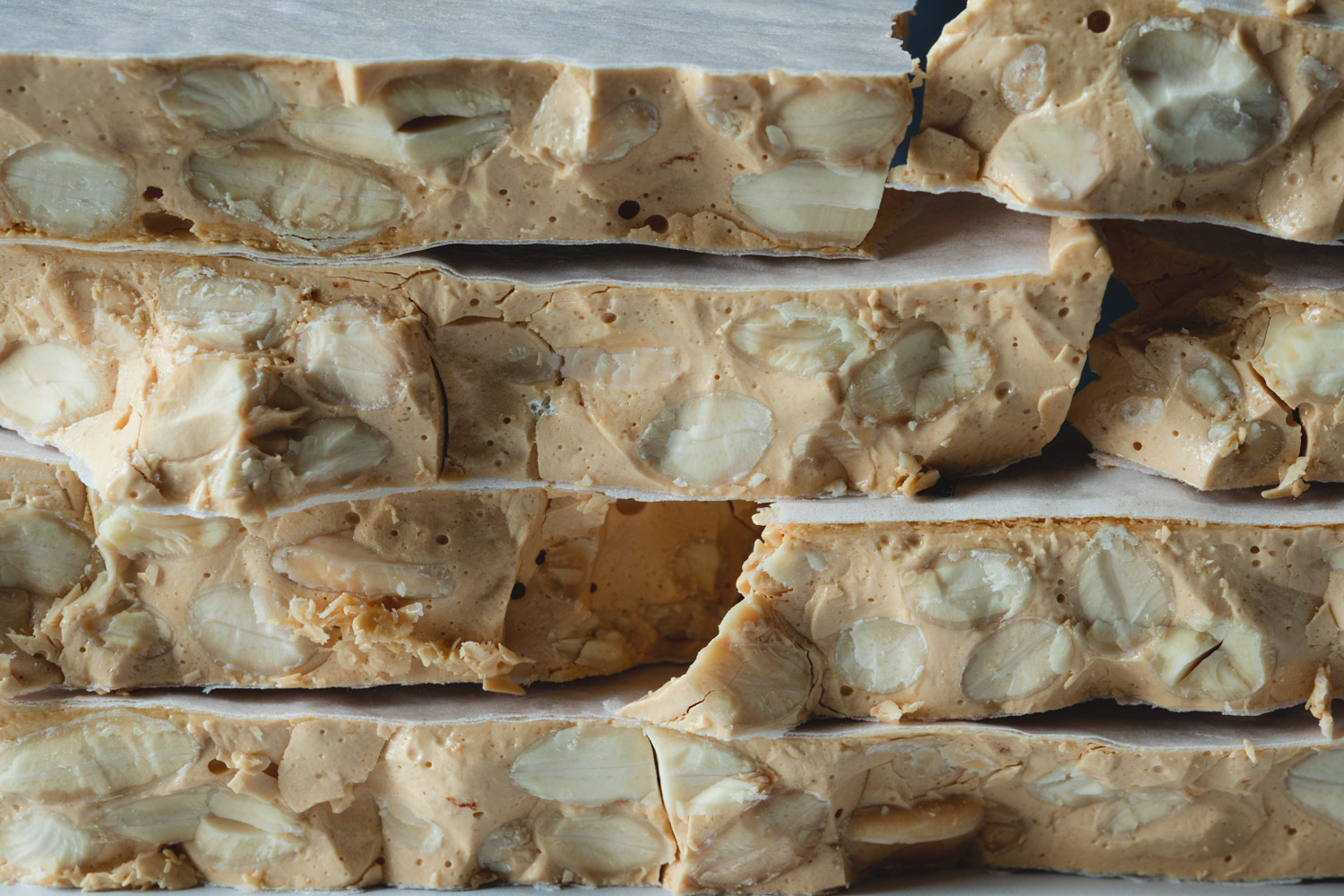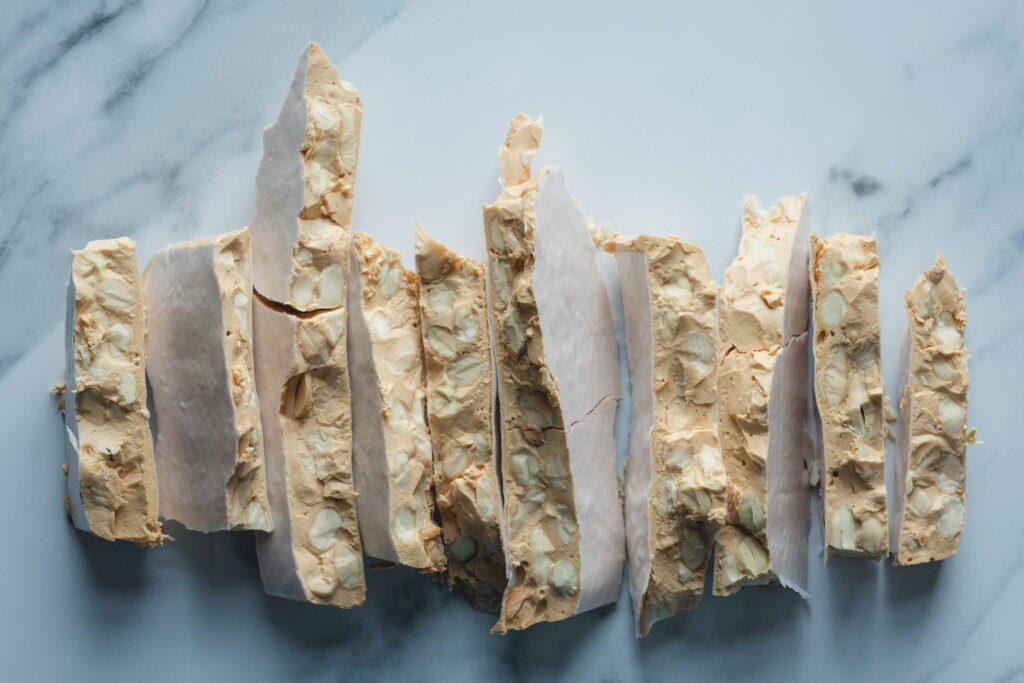
Some links may be affiliate links. We may get paid if you buy something or take an action after clicking one of these.
Turrón is Spanish nougat that’s a popular Christmas candy. As soon as the holiday season begins, you start to see turrón everywhere. It comes in hundreds of varieties and flavors, but the classic is made with almonds. This recipe for turrón de Alicante is loaded with toasted almonds and caramel-honey flavor.

What is Turrón Made From?
Generally, turrón is made from honey, sugar, egg white, and almonds. Nowadays there are hundreds of varieties of turrón.
It can be flavored with hazelnuts, pine nuts, chocolate, or unconventional flavors like crema Catalana or even cheese and nut. But, the two classics are turrón de Alicante and turrón de Jijona.
How to Make Turrón
To make turrón, a hot syrup made from the honey and sugar is whipped into beaten egg whites, similar to making meringue. The mixture is then cooked further on the stove until it becomes hard and breakable when cooled. The almonds are stirred in before transferring to a mold to cool.
While both turrón de Alicante and turrón de Jijona are made from the same ingredients, they couldn’t be more different.
Turrón de Jijona is soft and chewy. The almonds are ground to a paste before they’re stirred into the honey and egg whites. The oil released from grinding the nuts keeps the nougat soft.
Turrón de Alicante is made with toasted whole almonds, so the oil from the nuts aren’t mixed into the nougat, keeping it crunchy and brittle.
The History of Turrón
Turrón has been made in the Valencia region of Spain since at least the early 15th century. The recipe most likely arrived in Europe through Al-Andalus, as white nougat recipes were popular in the Arab world and show up in a 10th century cookbook from Baghdad.
Turrón spread to other regions of Spain and was first published in Spanish in the 16th century cookbook, Manual de Mujeres.
Nougat also spread outside of Spain. France and Italy have their own versions: Nougat de Montélimar in France and torrone in Italy.

Tips for Making Turrón de Alicante at Home:
While it’s easy to find authentic Spanish turrón, with a bit of patience, you can make it at home as well.
- Because of the high-temperature honey syrup and how sticky the mixture is, it’s really important to read through the recipe and prepare everything you need before starting. It’s not easy to pause when the syrup comes to temperature, and the nougat requires constant stirring.
- This recipe calls for edible wafer paper. The wafer paper prevents the turrón from sticking to the pan, to your knife, to itself… basically to everything. You can make it without by spraying the plastic wrap and the mold with oil, but the wafer paper makes it much easier.
- Line an 8-inch square baking pan with plastic wrap and cut the wafer paper to fit. Keep another piece of wafer paper nearby, trimmed to the right size. It helps to grease a rubber spatula lightly with oil and leave that by your mold to save for the last step.
- The honey syrup won’t take very long to reach the right temperature. Start beating the egg white as soon as you start cooking the honey and sugar. Then you won’t fumble with the hot syrup while trying to get the egg white to soft peaks.
- When whisking the syrup into the egg white, try your best to avoid pouring the syrup down the side of the bowl or onto the beaters. The beaters might whip the hot syrup out to the sides of the bowl. The sides of the bowl will cool down and harden the syrup, meaning less gets incorporated into the egg white, and more of a mess to clean later.
- While cooking the nougat on the stove, keep a small bowl or glass of water and some spoons nearby. Periodically check to see if the nougat is ready by cooling a small spoonful in the cold water. If the nougat is soft and malleable, it still needs more time. It’s ready once the nougat hardens and is easily broken.
- It may be tempting to turn up the heat to try and quicken things along. Keep the burner on low. If you turn up the burner, you risk burning the mixture. A higher temperature will also darken the mixture more.
- Keep the toasted almonds warm. If you try to mix cold almonds into the nougat, it will cool down and start to set, making it difficult to get out of the pan and press into the mold. I kept them in the turned-off oven while I was cooking the nougat.
- When transferring the nougat to the mold, switch to the greased rubber spatula you set aside before. This will help to shape it quickly without the nougat sticking to the spatula.
- Once you lay the top sheet of wafer paper over the nougat, use a flat-bottomed object (like a meat pounder or a glass) to gently press down on the turrón and flatten it. Be careful though, as the wafer paper tears easily.

Ingredients:
Yields one 8-inch (20cm) square block of nougat.
200g sugar
1 egg white
250g almonds
1 cup sugar
1 egg white
1 3/4 cups whole blanched almonds
2 sheets wafer paper
Toast the almonds:
Preheat the oven to 175°C (350°F). Toast the almonds on a baking sheet until fragrant and lightly golden brown, about 8 – 10 minutes.
Keep the almonds warm in the turned off oven with the door ajar.
Prepare the mold:
Line an 8-inch square baking pan with plastic wrap. Cut two pieces of wafer paper to fit. Lay one piece of wafer paper in the mold, with the shiny side facing down. Keep the other piece of wafer paper nearby.
Lightly grease a rubber spatula with oil and have it at the ready by the mold.
Make the honey syrup:
In a medium saucepan, combine the honey and the sugar. Set the pan over medium heat and cook until it reaches 115°C (240°F). Meanwhile, beat the egg white.
Beat the egg white:
Beat the egg white to soft peaks in the bowl of a stand mixer with the whisk attachment.
Make the nougat:
When the honey syrup has reached 115°C (240°F) and the egg white has formed soft peaks, slowly pour the hot syrup into the egg white with the mixer running.
If possible, avoid pouring the syrup on the whisk or the sides of the bowl. (The whisk will whip the hot syrup around the bowl, and the syrup stuck to the sides of the bowl will harden, rather than mixing into the nougat.)
At this point, the nougat should be bright white and shiny. Transfer the nougat back into the saucepan.
Cook the nougat:
Put the saucepan over low heat and cook the nougat, stirring constantly with a rubber spatula (not the greased one from earlier).
You can test the nougat for doneness by spooning a small amount into a cup of cold water. If the nougat hardens and becomes brittle, it’s done. It will take about 30 minutes.
Stir in the almonds:
Take the nougat off the heat and stir in the warm almonds, distributing them evenly.
Pour into the mold:
Pour the almond nougat into the mold. Now switch to the greased spatula to spread the nougat to the edges of the mold and press it down.
Top the nougat with the other piece of wafer paper, shiny side up. Use your hands or a flat-bottomed, heavy object to gently press down and flatten the nougat. Don’t use too much pressure, as the wafer paper tears easily.
Let the nougat set:
Let the nougat cool and harden for at least 2 hours, or overnight. Then peel back the plastic wrap, slice, and serve.
To slice hard nougat, use a sturdy knife and something to hammer with. I tapped the spine of my knife with a rolling pin to crack the turrón. (If you have an expensive, delicate Japanese knife, I would not use it for this task. I have a German chef’s knife from Wüsthof and I’m not too afraid of hurting it.)
Store the nougat in an airtight container. Keep away from humidity and don’t store it in the refrigerator so it doesn’t soften.
the Sunday Baker is a participant in the Amazon Services LLC Associates Program, an affiliate advertising program designed to provide a means for sites to earn advertising fees by advertising and linking to Amazon.com.

how many people does this feed
Hi Sharon! This makes approximately an 8×8-inch (20x20cm) square of turrón, which would be about 25 servings. Though most would eat more than one serving! Happy baking!